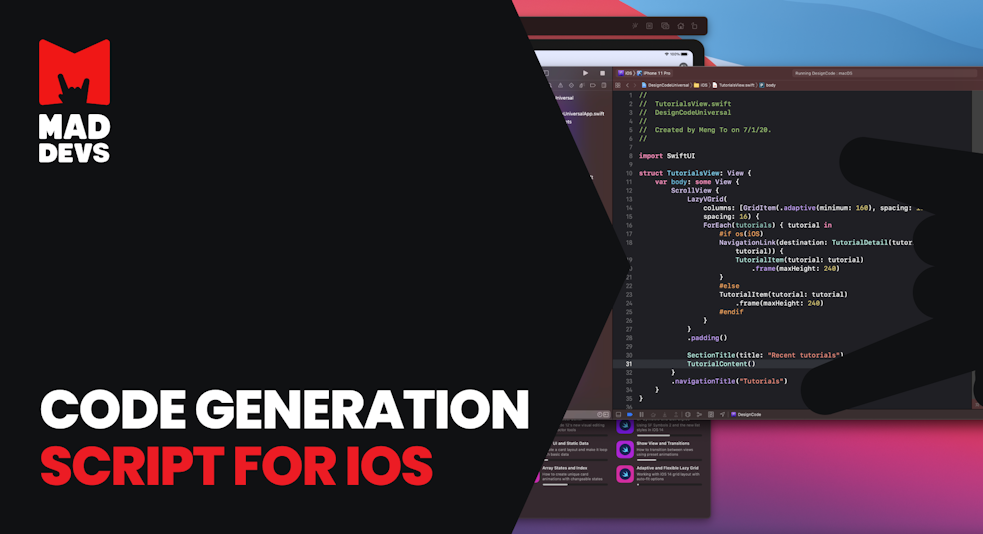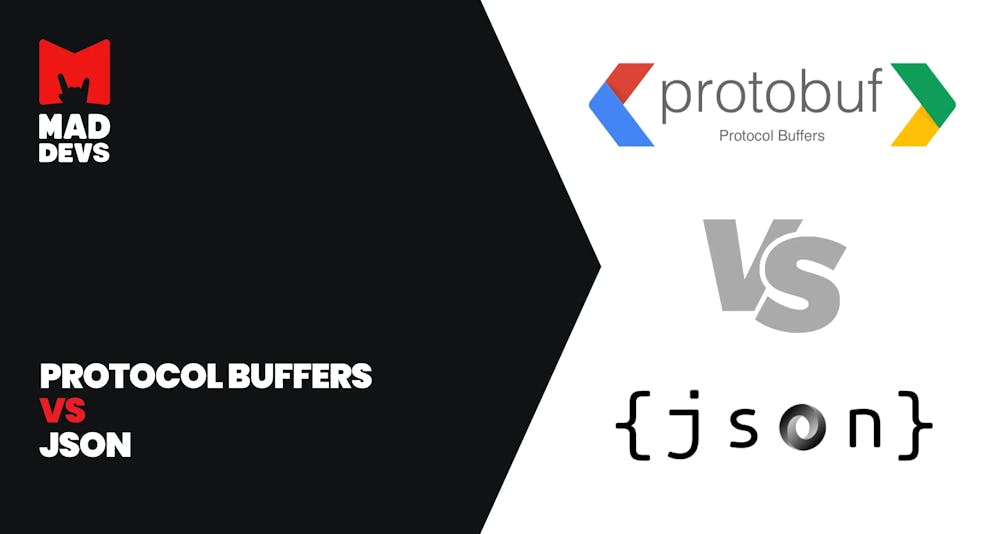In this article, I will show you an example of how can you speedup development with code generation scripting.
How can you speed up development with scripted code generation?
For code generation, I usually use Python or Ruby as these languages have a lot of libs for the generation of boilerplate code. And also these languages are first-class citizenship on macOS.
Real-life example: I had a lot of color themes in an application and a lot of colors, my designer changed colors once every month and added a new theme once a year.
Information was provided in JSON format:
{
"MainTheme": {
"textPrimary": {
"light": "#000000",
"dark": "#FFFFFF"
},
"textSecondary": {
"light": "#8A8A7E",
"dark": "#8D8D94"
},
...
},
...,
"BrightTheme": {
...
}
}
I had theme name and color type name with HEX code of color for light and dark modes.
So how should I convert this into the code?
In common situation you can transform hex into UIColor like that:
extension UIColor {
convenience init(rgb: Int) {
self.init(
red: (rgb >> 16) & 0xFF,
green: (rgb >> 8) & 0xFF,
blue: rgb & 0xFF
)
}
}
let color = UIColor(rgb: 0xFFFFFF)
But it is really uncomfortable to use colors in this way. I prefer color literal because can see the color:

Yeah, it is much better. Let’s do it this way.
First of all, we should create a swift file where our colors will be — “AppColors.generated.swift”.
After that, as we are using Ruby we should prepare a project for using Ruby.
- Make sure Ruby and Gem are installed;
- Call the
bundle installcommand in the project’s iOS root folder — it will install the required gems; Liquidis one of the required gems — we will use it for creating templates.
Also, we should have raw resources for colors — JSON with colors. Let’s name it “ios_colors.json”.
The liquid is very useful for preparing templates. Example of our template “ColorsTemplate.liquid”:
import UIKit
/// Extension representing a pool of new colors
public extension UIColor {
static func getColor(lightMode: UIColor, darkMode: UIColor) -> UIColor {
if #available(iOS 13.0, *) {
return UIColor { (traits) -> UIColor in
return traits.userInterfaceStyle != .dark ? lightMode : darkMode
}
} else {
return lightMode
}
}
{% for keyVal in data %}
struct {{ keyVal[0] }} {
{% for key in keyVal[1] %}
public static let {{ key[0] }}: UIColor = getColor(
lightMode: #colorLiteral(
red: {{ key[1].lightRed }},
green: {{ key[1].lightGreen }},
blue: {{ key[1].lightBlue }},
alpha: {{ key[1].lightOpacity }}
),
darkMode: #colorLiteral(
red: {{ key[1].darkRed }},
green: {{ key[1].darkGreen }},
blue: {{ key[1].darkBlue }},
alpha: {{ key[1].darkOpacity }}
)
) ///{{ key[1].lightHex }} | {{ key[1].darkHex }}
{% endfor %}
}
{% endfor %}
}
Now the most interesting process — writing script. I will just leave code on Ruby:
require 'Liquid' require 'json'class Colors attr_accessor :lightRed, :lightGreen, :lightBlue, :darkRed, :darkGreen, :darkBlue, :lightHex, :darkHex, :lightOpacity, :darkOpacity def initialize(light, dark) @lightHex = light @darkHex = dark if light.size > 7 then *tempLight, alpha = light.match(/^#(..)(..)(..)(..)?$/).captures.map(&:hex) @lightRed = (tempLight[0] / 255.0).round(2) @lightGreen = (tempLight[1] / 255.0).round(2) @lightBlue = (tempLight[2] / 255.0).round(2) @lightOpacity = (alpha || 255) / 255.0 else tempLight = light.match(/^#(..)(..)(..)$/).captures.map(&:hex) @lightRed = (tempLight[0] / 255.0).round(2) @lightGreen = (tempLight[1] / 255.0).round(2) @lightBlue = (tempLight[2] / 255.0).round(2) @lightOpacity = 1.0 end if dark.size > 7 then *tempDark, alpha = dark.match(/^#(..)(..)(..)(..)?$/).captures.map(&:hex) @darkRed = (tempDark[0] / 255.0).round(2) @darkGreen = (tempDark[1] / 255.0).round(2) @darkBlue = (tempDark[2] / 255.0).round(2) @darkOpacity = (alpha || 255) / 255.0 else tempDark = dark.match(/^#(..)(..)(..)$/).captures.map(&:hex) @darkRed = (tempDark[0] / 255.0).round(2) @darkGreen = (tempDark[1] / 255.0).round(2) @darkBlue = (tempDark[2] / 255.0).round(2) @darkOpacity = 1.0 end end def to_hash tempHash = Hash.new tempHash['lightRed'] = @lightRed tempHash['lightGreen'] = @lightGreen tempHash['lightBlue'] = @lightBlue tempHash['darkRed'] = @darkRed tempHash['darkGreen'] = @darkGreen tempHash['darkBlue'] = @darkBlue tempHash['lightHex'] = @lightHex tempHash['darkHex'] = @darkHex tempHash['lightOpacity'] = @lightOpacity tempHash['darkOpacity'] = @darkOpacity tempHash end def to_json to_hash.to_json end endclass Constants private TABLE_SEPARATOR = "----------------------------------------------------------------------------------" JSON_TYPE = ".json" COLORS_JSON_FOLDER = 'Utils/Utils/Resources/Colors/' TEMPLATE_FILEPATH = 'Utils/Utils/Resources/Colors/ColorsTemplate.liquid' COLORS_ENUM_FILEPATH = 'Utils/Utils/Generated/AppColors.generated.swift' end# Find all colors json files json_files = Dir.entries(Constants::COLORS_JSON_FOLDER).select {|f| f.include? Constants::JSON_TYPE }header_string = "Finded JSON files:" header_string = "| #{header_string} |" puts header_string# get all colors from files color_duplicates = Hash.new result_json_data = Hash.newjson_files.each do |filename| context = File.read("#{Constants::COLORS_JSON_FOLDER}#{filename}") @templateFile = File.read(Constants::TEMPLATE_FILEPATH) @outputFile = Constants::COLORS_ENUM_FILEPATH json = JSON.parse(context) result_json_data["#{json.keys[0]}"] = Hash[json["#{json.keys[0]}"].map { |key, value| [ key, Hash[ Colors.new(value['light'], value['dark']).to_hash ] ] }] end puts Constants::TABLE_SEPARATOR# convert json feature toggles to enum @template = Liquid::Template.parse(@templateFile) # Parses and compiles the template @rendered = @template.render({'data' => result_json_data}) File.write(@outputFile, @rendered)
Ok, usually I save all scripts in the root directory as it is easy to use them. Name of our script file “convertColorsToStatic.rb”.
Let’s call in the terminal:
ruby convertColorsToStatic.rb
Voila:

Also I’m using scripts for creating events, feature toggles, strings, architecture components (for example, VIPER) and it saves me ton of time.

Tech Stack of Prominent Companies: What Are Industry...
Tech Stack of Prominent Companies:...
Tech Stack of Prominent Companies: What Are Industry Giants Using to Power Their Applications?
Netflix vs. Hulu, Hubspot vs. Salesforce, Spotify vs. Pandora, Databrick vs. ByteDance, Canva vs. Miro, and Uber vs Lyft are the rivalries that...






